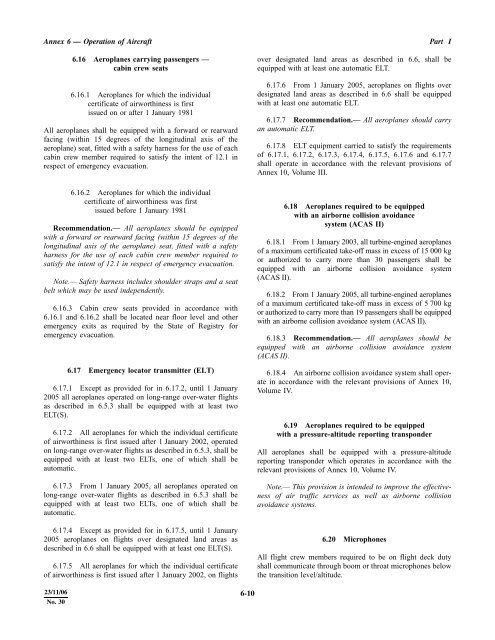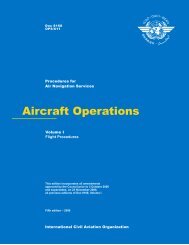Operation of Aircraft
Annex 6, Part I
Annex 6, Part I
- No tags were found...
Create successful ePaper yourself
Turn your PDF publications into a flip-book with our unique Google optimized e-Paper software.
Annex 6 — <strong>Operation</strong> <strong>of</strong> <strong>Aircraft</strong><br />
6.16 Aeroplanes carrying passengers —<br />
cabin crew seats<br />
6.16.1 Aeroplanes for which the individual<br />
certificate <strong>of</strong> airworthiness is first<br />
issued on or after 1 January 1981<br />
All aeroplanes shall be equipped with a forward or rearward<br />
facing (within 15 degrees <strong>of</strong> the longitudinal axis <strong>of</strong> the<br />
aeroplane) seat, fitted with a safety harness for the use <strong>of</strong> each<br />
cabin crew member required to satisfy the intent <strong>of</strong> 12.1 in<br />
respect <strong>of</strong> emergency evacuation.<br />
6.16.2 Aeroplanes for which the individual<br />
certificate <strong>of</strong> airworthiness was first<br />
issued before 1 January 1981<br />
Recommendation.— All aeroplanes should be equipped<br />
with a forward or rearward facing (within 15 degrees <strong>of</strong> the<br />
longitudinal axis <strong>of</strong> the aeroplane) seat, fitted with a safety<br />
harness for the use <strong>of</strong> each cabin crew member required to<br />
satisfy the intent <strong>of</strong> 12.1 in respect <strong>of</strong> emergency evacuation.<br />
Note.— Safety harness includes shoulder straps and a seat<br />
belt which may be used independently.<br />
6.16.3 Cabin crew seats provided in accordance with<br />
6.16.1 and 6.16.2 shall be located near floor level and other<br />
emergency exits as required by the State <strong>of</strong> Registry for<br />
emergency evacuation.<br />
6.17 Emergency locator transmitter (ELT)<br />
6.17.1 Except as provided for in 6.17.2, until 1 January<br />
2005 all aeroplanes operated on long-range over-water flights<br />
as described in 6.5.3 shall be equipped with at least two<br />
ELT(S).<br />
6.17.2 All aeroplanes for which the individual certificate<br />
<strong>of</strong> airworthiness is first issued after 1 January 2002, operated<br />
on long-range over-water flights as described in 6.5.3, shall be<br />
equipped with at least two ELTs, one <strong>of</strong> which shall be<br />
automatic.<br />
6.17.3 From 1 January 2005, all aeroplanes operated on<br />
long-range over-water flights as described in 6.5.3 shall be<br />
equipped with at least two ELTs, one <strong>of</strong> which shall be<br />
automatic.<br />
6.17.4 Except as provided for in 6.17.5, until 1 January<br />
2005 aeroplanes on flights over designated land areas as<br />
described in 6.6 shall be equipped with at least one ELT(S).<br />
6.17.5 All aeroplanes for which the individual certificate<br />
<strong>of</strong> airworthiness is first issued after 1 January 2002, on flights<br />
Part I<br />
over designated land areas as described in 6.6, shall be<br />
equipped with at least one automatic ELT.<br />
6.17.6 From 1 January 2005, aeroplanes on flights over<br />
designated land areas as described in 6.6 shall be equipped<br />
with at least one automatic ELT.<br />
6.17.7 Recommendation.— All aeroplanes should carry<br />
an automatic ELT.<br />
6.17.8 ELT equipment carried to satisfy the requirements<br />
<strong>of</strong> 6.17.1, 6.17.2, 6.17.3, 6.17.4, 6.17.5, 6.17.6 and 6.17.7<br />
shall operate in accordance with the relevant provisions <strong>of</strong><br />
Annex 10, Volume III.<br />
6.18 Aeroplanes required to be equipped<br />
with an airborne collision avoidance<br />
system (ACAS II)<br />
6.18.1 From 1 January 2003, all turbine-engined aeroplanes<br />
<strong>of</strong> a maximum certificated take-<strong>of</strong>f mass in excess <strong>of</strong> 15 000 kg<br />
or authorized to carry more than 30 passengers shall be<br />
equipped with an airborne collision avoidance system<br />
(ACAS II).<br />
6.18.2 From 1 January 2005, all turbine-engined aeroplanes<br />
<strong>of</strong> a maximum certificated take-<strong>of</strong>f mass in excess <strong>of</strong> 5 700 kg<br />
or authorized to carry more than 19 passengers shall be equipped<br />
with an airborne collision avoidance system (ACAS II).<br />
6.18.3 Recommendation.— All aeroplanes should be<br />
equipped with an airborne collision avoidance system<br />
(ACAS II).<br />
6.18.4 An airborne collision avoidance system shall operate<br />
in accordance with the relevant provisions <strong>of</strong> Annex 10,<br />
Volume IV.<br />
6.19 Aeroplanes required to be equipped<br />
with a pressure-altitude reporting transponder<br />
All aeroplanes shall be equipped with a pressure-altitude<br />
reporting transponder which operates in accordance with the<br />
relevant provisions <strong>of</strong> Annex 10, Volume IV.<br />
Note.— This provision is intended to improve the effectiveness<br />
<strong>of</strong> air traffic services as well as airborne collision<br />
avoidance systems.<br />
6.20 Microphones<br />
All flight crew members required to be on flight deck duty<br />
shall communicate through boom or throat microphones below<br />
the transition level/altitude.<br />
1/11/01 23/11/06<br />
6-10<br />
No. 30












